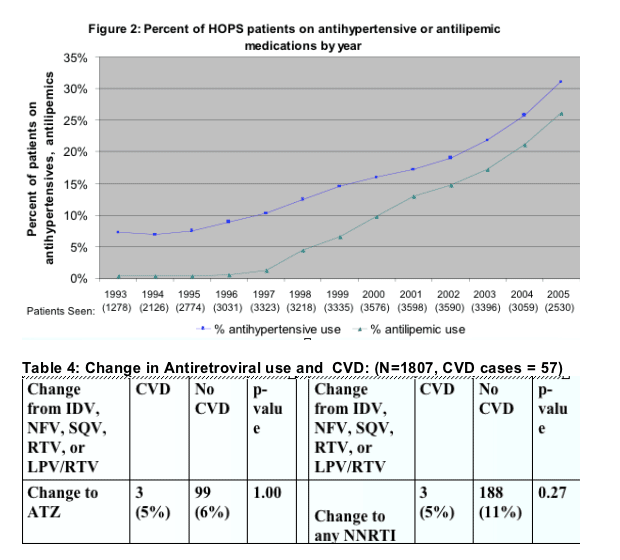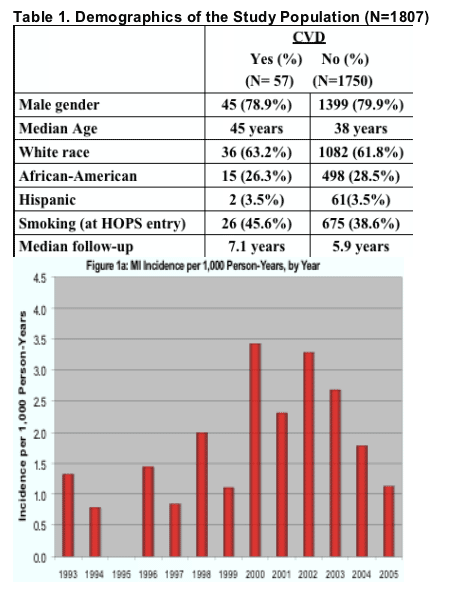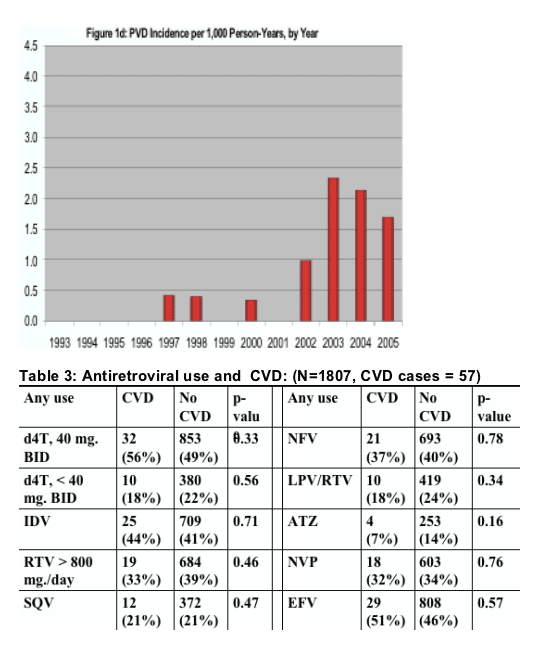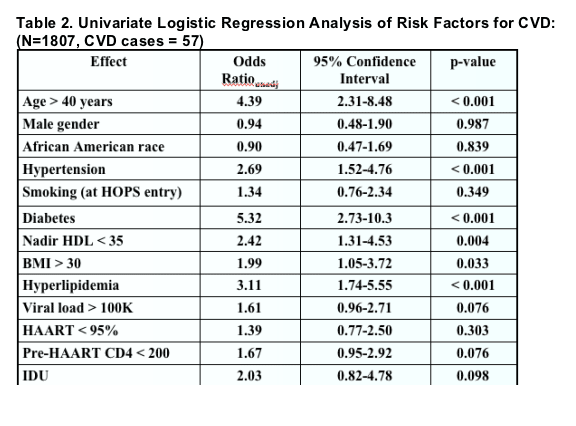 |
 |
 |
| |
Analysis of Cardiovascular Risk Factors in the HIV Outpatient Study (HOPS) Cohort
|
| |
| |
Reported by Jules Levin
13th CROI, Feb 5-8, 2006, Denver
I reported to you results from the D.A.D. study & cardiovascular risk in HIV, the poster from Kaiser reporting their current experience in heart disease, and now from HOPS.
Authors - KA Lichtenstein1, C Armon2, K Buchacz3, AC Moorman3, KC Wood2, JT Brooks3, and the HOPS Investigators
1University of Colorado Health Sciences Center, Denver, CO; 2Cerner Corporation, Vienna, VA; 3Centers for Disease Control and Prevention, Atlanta, GA
-- (31%) had 8 years of follow-up.
-- 1,807 patients met inclusion criteria for this analysis, of whom 57 (3.2%) contributed 84 total CVD diagnoses: 13 MI, 2 PVD, 57 CAD, and 12 stroke diagnoses (see graphs tracking trends in past 10+ years)
-- risk of CVD was associated with traditional CVD risk factors, reduced by use of antihypertensive and lipid-lowering agents, and was unrelated to changes in ART
-- MI cases peaked from 2000 to 2002 and have been decreasing in frequency in subsequent years coincident with increased use of medications for hypertension and hyperlipidemia.
risk factors:
-- Age > 40 years at pre-HAART CD4 (3.31),
-- diabetes (3.24),
-- hyperlipidemia (1.95), and
-- nadir HDL (0.97).
-- the program abstract also lists hypertension (2.2) as a risk factor in multivariate analysis
Abstract in program book said:
Univariate analysis demonstrated a trend toward a decreased risk of CVD in patients who remained on HAART 95% of the time over an 8-year period (c2 test for trend, p = 0.056). Within a subset of patients who had data on triglycerides (n = 435), cholesterol (n = 460), LDL (n = 406), and HDL (n = 422) over the 8-year period, changes in total cholesterol, LDL, HDL, and triglycerides were all more favorable in the ≥95% vs <95% groups (total cholesterol: 3.6 vs 8.5 mg/dL; LDL -3.4 vs 1.9 mg/dL; HDL 1.0 vs 1.2 mg/dL; triglycerides 13.7 vs 48.6 mg/dL, respectively).


Background:
Lipid abnormalities and cardiovascular disease (CVD) in HIV-infected patients have led to concerns about the contribution of antiretroviral agents to these co-morbidities.
Methods:
- We analyzed a prospective, dynamic cohort of >8,000 patients followed since 1993 in the HOPS. We used chi-square and logistic regression analyses to assess risk factors for cardiovascular events (myocardial infarction (MI), peripheral vascular disease (PVD), coronary artery disease (CAD) and stroke), including time on HAART after its initiation (took HAART >95% vs. <95% of the time). We used Cox proportional hazards regression to assess the impact of treatment of hyperlipidemia on cardiovascular events.
- Study Population: We included patients with visits from 3/1/1996 through 9/30/2005 who were either ARV-naive or who had completely documented ARV histories, with at least 90 days of HAART experience. In addition, patients must have had at least one of each of the following tests: total cholesterol, HDL, LDL, triglycerides, or glucose. We limited the Cox proportional hazards analysis of risk factors for CVD among patients with hyperlipidemia to the subset of patients diagnosed with hyperlipidemia during the observation period.
- Definitions: "Smoking" indicated a current cigarette smoker at the time of entry into the HOPS. Diabetes was determined by diagnosis, treatment for diabetes, elevated hemoglobin A1C, or elevated fasting insulin or glucose levels (>ULN for all tests). Hypertension and hyperlipidemia were determined by clinician diagnosis of each condition.
Results
- From 1993-2005, among 8,024 total patients followed in the HOPS, there were 57 MIs (Figure 1a), 22 cases of PVD (Figure 1b), 86 cases of CAD (Figure 1c) and 22 cases of PVD (Figure 1d). MI cases peaked from 2000 and declined thereafter (Figure 1a) coincident with increased use of medications for hypertension and hyperlipidemia (Figure 2).
- 1,807 patients met inclusion criteria for this analysis, of whom 57 (3.2%) contributed 84 total CVD diagnoses: 13 MI, 2 PVD, 57 CAD, and 12 stroke diagnoses. Patients with CVD were older, and had a longer follow-up time than patients without CVD (Table 1).
- In the multivariate analysis (Figure 4), significant (p<0.05) independent risk factors for CVD were (adjusted odds ratio shown in parentheses):
-- Age > 40 years at pre-HAART CD4 (3.31),
-- diabetes (3.24),
-- hyperlipidemia (1.95), and
-- nadir HDL (0.97).
-- the program abstract also lists hypertension (2.2) as a risk factor in multivariate analysis
Pre-HAART CD4 count, percent of time on HAART since start of first HAART regimen, BMI>30, peak viral burden, peak total cholesterol, peak LDL, peak triglycerides, specific antiretroviral agents or classes (Table 3), antiretroviral switches to other drugs or classes (Table 4), smoking, IDU, gender, or race/ethnicity were not statistically associated with CVD (data not shown).
- Use of lipid-lowering agents was associated with reduced risk for CVD among patients with hyperlipidemia (Table 5) (HR=0.34, p=0.02).
Conclusions
- Among HOPS patients, the majority of whom are white and male, the risk of cardiovascular disease was associated with traditional CVD risk factors: older age, preexisting hyperlipidemia, diabetes, and low nadir HDL.
- The risk of CVD was lowered with use of lipid lowering agents, but was unrelated to specific antiretroviral agents or changes in antiretroviral therapy.




|
|
| |
| |
|
 |
 |
|
|